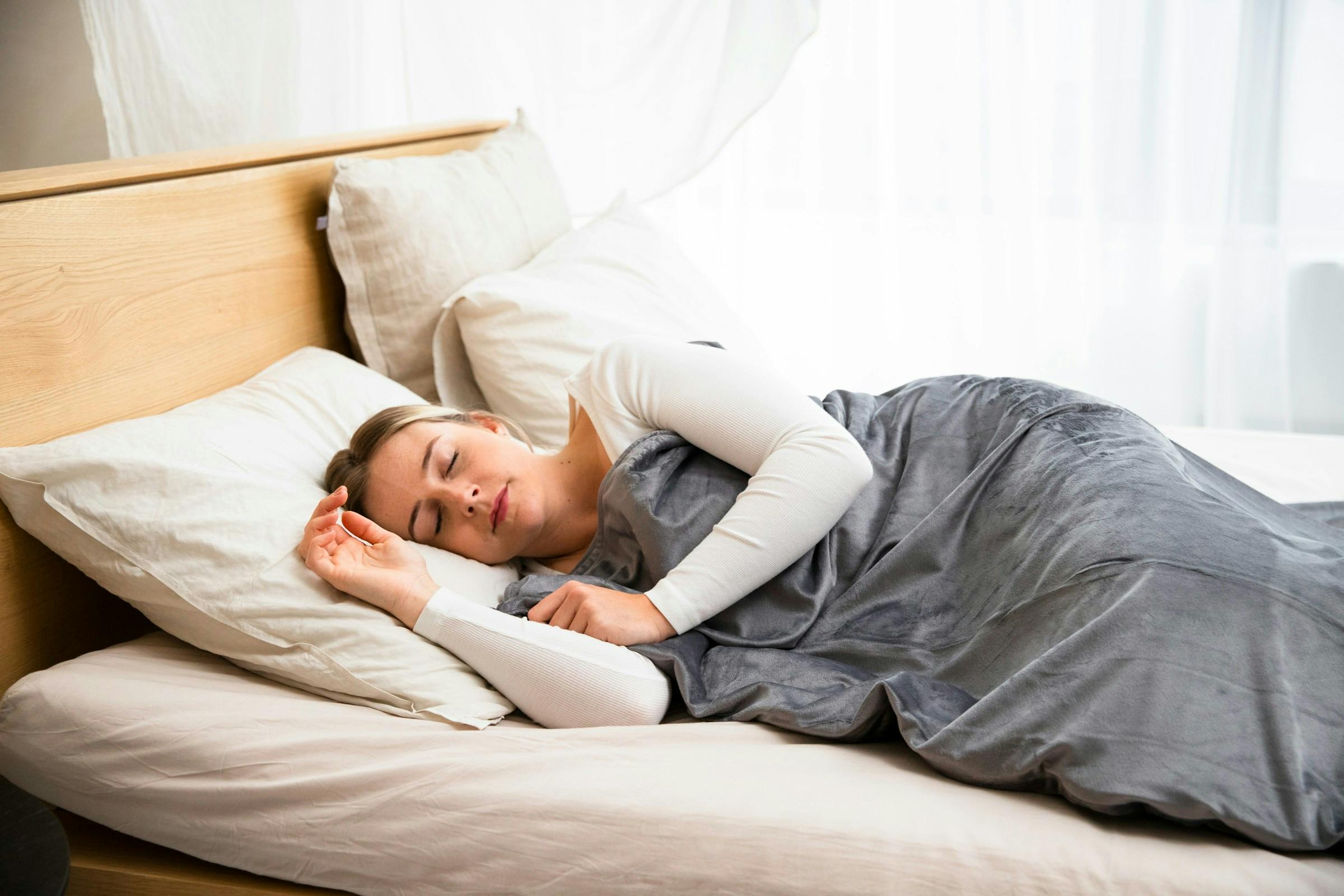5 Science-Backed Ways to Relieve PCOS Pain at Home
By Lilian E.
Reviewed by Kenya Bass, PA-C
Published Jun 30, 2025
11 min read

Living with PCOS (Polycystic Ovary Syndrome) can feel overwhelming, especially when it comes with chronic pain that’s hard to describe, harder to treat, and often ignored. While many people associate PCOS with irregular periods, fertility issues, and hormonal imbalances, pain is one of the most distressing and under-discussed symptoms. It can show up as sharp pelvic cramps, bloating, lower back pain, or even full-body inflammation that just doesn’t seem to go away.
If you’re one of the millions dealing with this frustrating aspect of PCOS, you’re not alone. And more importantly, there are practical ways to ease the pain right at home—without having to rely solely on medications or expensive treatments.
In this guide, we’ll walk you through five simple, research-supported ways to relieve PCOS pain from the comfort of your home. Whether you're struggling with pelvic discomfort, body aches, or inflammation-related pain, these tips are meant to give you back a sense of control—and a bit more peace.
Why Does PCOS Cause Pain in the First Place?
Before diving into relief strategies, it helps to understand where the pain is coming from. PCOS isn’t just a hormone issue—it’s also an inflammatory condition. That means your body tends to stay in a low-grade state of inflammation, which can trigger or worsen pain.
Pain can come from enlarged ovaries with cysts, but that’s not always the case. Many people with PCOS experience:
- Chronic pelvic pain
- Menstrual cramps that feel more intense than usual
- Bloating and pressure
- Digestive discomfort
- Backaches and joint stiffness
- Body-wide fatigue and soreness
Hormones like insulin, cortisol, and androgens are often out of balance in PCOS. These imbalances can lead to everything from high blood sugar to poor sleep to muscle tension—all of which can make pain worse. But here’s the good news: you can help reduce inflammation, ease muscle tension, and support hormonal balance naturally by making small, sustainable changes at home.
Let’s get into it.
1. Eat to Ease Inflammation: Your Diet Can Calm PCOS Pain
You might have heard that “food is medicine.” And when it comes to PCOS pain, that saying couldn’t be more accurate. What you eat every day directly impacts your levels of inflammation, insulin, and pain sensitivity.
Many people with PCOS have higher-than-normal levels of insulin and CRP (C-reactive protein), both of which signal inflammation in the body. Diets high in refined sugar, processed foods, and low in fiber can throw your hormones out of whack and cause inflammation to flare up, leading to more pain.
The good news? Shifting to a more anti-inflammatory eating style can actually help soothe your system. That doesn’t mean you need to follow a strict diet or give up everything you love. It’s more about adding the right kinds of foods and making simple swaps.
Try including more:
- Omega-3-rich foods like wild salmon, walnuts, chia seeds, and flaxseeds. These fats help reduce inflammation and support hormone health.
- Colorful fruits and vegetables, especially leafy greens, berries, and cruciferous veggies like broccoli. These are packed with antioxidants and phytonutrients that cool down inflammation.
- Whole grains and fiber-rich foods like oats, quinoa, lentils, and beans. Fiber supports gut health and helps regulate insulin.
- Spices like turmeric and ginger which have powerful anti-inflammatory properties.
At the same time, try to cut back on foods that trigger inflammation, like sugary snacks, fried foods, processed meats, and white bread. You don’t need to be perfect; just try to crowd out the pain-triggering foods with healing, whole foods instead.
Some people also find relief when they reduce dairy or gluten, especially if they have food sensitivities. Listen to your body and consider keeping a food and symptom journal to see what works best for you.
2. Heat Therapy: A Simple Yet Powerful Tool for Pain Relief
If you’ve ever used a heating pad during your period, you already know how comforting warmth can be for cramps. That same principle applies to PCOS pain, especially when it’s centered around the lower abdomen or back.
Heat therapy helps increase blood flow, relax tight muscles, and reduce cramping and pelvic tension. It also stimulates heat receptors in the skin that override pain signals being sent to the brain. This makes your pain feel less intense, even if the underlying cause hasn’t gone away yet.
You can use heat therapy in several ways:
- Apply a heating pad or hot water bottle to your lower abdomen for 15–30 minutes at a time, especially during flare-ups.
- Take a warm bath with Epsom salts to help relax your whole body and soothe muscle tension.
- Try a warm rice sock or heating patch if you’re on the go or don’t have access to a bath.
Some people find even more relief when they pair heat with deep breathing or gentle stretching (more on that next). While heat won’t solve the hormonal root of PCOS pain, it’s a fast and safe way to feel better in the moment, especially on tough days.
3. Move Gently: How Low-Impact Exercise Reduces PCOS Pain

When you’re in pain, moving your body might be the last thing on your mind. But the truth is, gentle physical activity can be one of the most effective ways to manage chronic PCOS pain—and it comes with zero side effects.
Exercise helps reduce inflammation, improve circulation, balance insulin, and boost mood—all of which play a role in managing pain. But we’re not talking about high-intensity workouts or exhausting gym sessions. In fact, intense exercise can sometimes raise cortisol and backfire for people with PCOS.
Instead, focus on slow, steady movement that feels good and is easy to stick with. This could be something as simple as:
- A 20-minute walk outside (bonus: sunlight helps regulate your sleep and hormones)
- A gentle yoga flow with stretches that open the hips and release pelvic tension
- Basic at-home mobility work or Pilates to strengthen your core and improve posture
Yoga, in particular, has been studied for its role in improving PCOS symptoms, including pain, anxiety, and hormone regulation. One pose that’s great for pelvic pain is Supta Baddha Konasana (reclining bound angle pose), which opens the hips and calms the nervous system.
The key is consistency. You don’t need to do a lot—just a little, regularly. Even 10 minutes a day can start to make a difference in how your body feels.
4. Stress Management: A Must-Have for Pain and Hormone Relief
Here’s something many people don’t realize: chronic stress can directly cause and worsen pain, especially if you have PCOS.
When you’re stressed, your body releases cortisol, your main stress hormone. High cortisol over time can increase inflammation, spike insulin levels, disrupt your sleep, and create more muscle tension—all of which make PCOS symptoms worse. That includes pain.
That’s why learning how to calm your stress response is not just a “nice idea”—it’s a crucial step in managing PCOS-related pain. And you don’t need to spend hours meditating or book a silent retreat. There are simple, effective ways to reduce stress right at home.
Try these ideas:
- Box breathing: Inhale for 4 seconds, hold for 4 seconds, exhale for 4 seconds, hold for 4 more, and repeat. This slows your nervous system and helps your body shift from “fight or flight” to “rest and digest.”
- Journaling: Even writing for 5–10 minutes a day can help you process emotions, track symptoms, and feel more in control.
- Nature exposure: Just sitting outside, walking barefoot in the grass, or soaking up some morning sun can lower cortisol and boost serotonin.
- Digital detox: Reducing screen time—especially before bed—helps your brain wind down and improves sleep quality.
Over time, managing stress becomes a form of pain prevention. The more relaxed your body feels, the less tension it holds—and the more resilient your hormones become.
5. Try Natural Supplements That Target Inflammation and Cramping
Supplements can be a helpful part of your PCOS toolkit—especially when it comes to easing pain, reducing inflammation, and supporting better sleep. One of the most widely recommended nutrients for PCOS pain is magnesium.
Magnesium is involved in over 300 body processes, including muscle relaxation, nerve function, and blood sugar regulation. It’s known for reducing cramping, easing tension headaches, supporting sleep, and even calming anxiety—all issues that often show up with PCOS.
Forms like magnesium glycinate and magnesium citrate are easy to absorb and gentle on the stomach. Many people notice fewer cramps and less tension after adding a daily magnesium supplement to their routine.
Other helpful supplements for pain relief and inflammation include:
- Omega-3 fatty acids (especially from fish oil): These reduce inflammatory markers and may help with period pain and overall hormone balance.
- Curcumin, the active compound in turmeric: Known for its strong anti-inflammatory properties, curcumin may reduce joint and pelvic pain.
- Inositol, a B-vitamin-like compound: Often used to support insulin sensitivity in PCOS, which may indirectly help reduce pain triggered by blood sugar crashes.
Always check with a healthcare provider before starting any new supplement, especially if you’re taking other medications. But in many cases, these natural options can offer real relief without harsh side effects.
RELATED READ: 10 Best Supplements for PCOS Relief: Natural Support for Hormones, Weight, and Fertility
Bonus Tip: Don’t Underestimate the Power of Sleep
Sleep might seem unrelated to pain, but for people with PCOS, it’s one of the most powerful tools for healing. Poor sleep increases cortisol, throws off your insulin response, and heightens your body’s sensitivity to pain.
If you struggle with falling or staying asleep, try these simple strategies:
- Stick to a regular sleep schedule—even on weekends
- Avoid screens at least an hour before bed
- Use blackout curtains or a sleep mask to reduce light exposure
- Sip a calming herbal tea like chamomile or lemon balm

Quality sleep helps your body reset inflammation, regulate hormones, and restore energy, making it a secret weapon in the fight against PCOS pain.
When Should You See a Doctor for PCOS Pain?
While these at-home tips can make a big difference, it’s important to know when pain is not normal and needs medical attention.
If you’re experiencing any of the following, don’t try to “tough it out”—speak with a provider who understands PCOS:
- Sharp, sudden pelvic pain that doesn't go away
- Pain during sex
- Bloating or abdominal pressure that feels new or intense
- Pain accompanied by fever, nausea, or heavy bleeding
- Pain that disrupts your daily life or mental health
Chronic pain isn’t something you just have to live with. There are doctors, pelvic floor therapists, and hormone specialists who can help you find answers and long-term solutions. The best approach often combines lifestyle changes plus personalized medical support.
The Bottom Line: You Don’t Have to Live in Pain
PCOS pain is real—and valid. Whether it shows up in your belly, back, or all over your body, it’s a signal that your system needs support. The good news is that you don’t need to overhaul your entire life to start feeling better.
Simple, science-backed steps like eating to fight inflammation, using heat, moving gently, managing stress, and trying the right supplements can all work together to calm your system and restore comfort.
Start small. Pick one strategy that feels doable and stick with it for a few weeks. Over time, these tiny acts of self-care add up to big changes.
And remember, you're not alone in this. PCOS pain is common, but that doesn’t mean it’s normal. You deserve answers. You deserve relief. And most of all, you deserve to feel at home in your body again.
Frequently Asked Questions (FAQ)
1: Can PCOS cause chronic pelvic pain even without cysts?
Yes. While cysts can contribute to discomfort, many people with PCOS experience chronic pain due to hormonal imbalances, inflammation, and insulin resistance, regardless of cyst presence.
2: Does losing weight help with PCOS pain?
For some individuals, moderate weight loss can help improve insulin sensitivity and reduce inflammation, which may ease pain. However, it’s not a guaranteed fix, and PCOS affects people of all body sizes.
3: Can birth control stop PCOS pain?
Hormonal birth control may reduce menstrual cramps and regulate cycles, which can help some with PCOS pain. But it doesn't treat the root causes of PCOS and isn’t the right fit for everyone.
4: Are essential oils helpful for PCOS pain?
Some people find relief using lavender or clary sage oil for cramping or stress, but scientific evidence is limited. Essential oils should be used with caution and never ingested.
5: How long does it take for at-home PCOS pain relief strategies to work?
Some methods like heat therapy provide immediate relief. Others—like diet changes or supplements—may take a few weeks to show consistent improvements. Patience and consistency are key.
Share this article

Tips for Staying Healthy: 12 Simple Habits for Energy, Longevity, and Better Living
Editorial Team
Sep 30, 202510 min read

Is Eating Before Bed Bad? What Science Really Says About Late-Night Snacking
Editorial Team
Sep 25, 202512 min read

Low Sodium Diet: Simple Guidelines, Food Lists, and Tips for Better Health
Lilian E.
Sep 30, 202512 min read

Best-in-class care is a click away
Find everything and everyone you need to reach your metabolic health goals, in one place. It all makes sense with Meto.
Join Meto